nee Accountant
VerifiedAdded on 2023/01/12
|14
|2614
|66
AI Summary
Hello team,
I would like to get an A or B grade for this work.
I will attach photos with all the requirements.
Thank you.
Contribute Materials
Your contribution can guide someone’s learning journey. Share your
documents today.
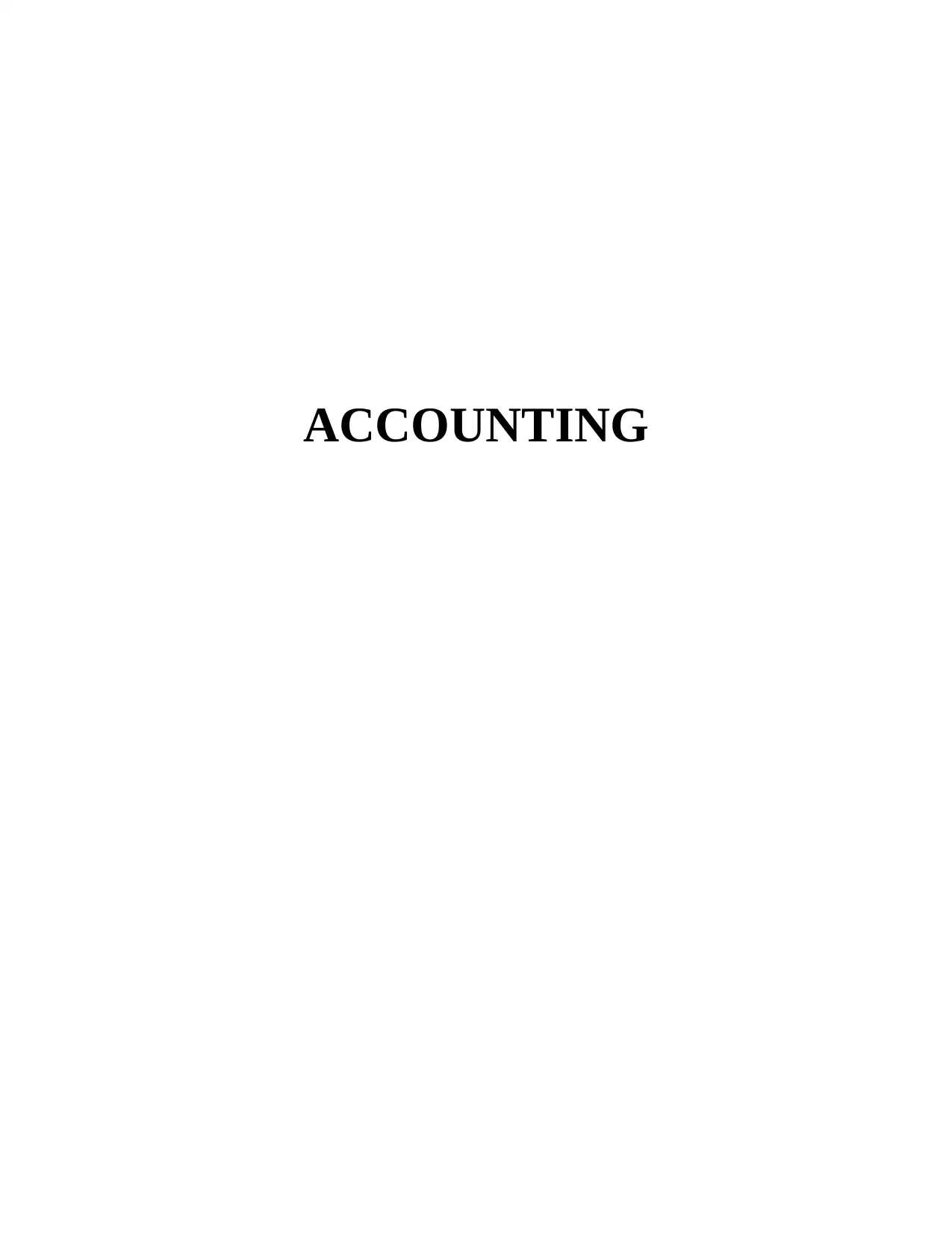
ACCOUNTING
Secure Best Marks with AI Grader
Need help grading? Try our AI Grader for instant feedback on your assignments.
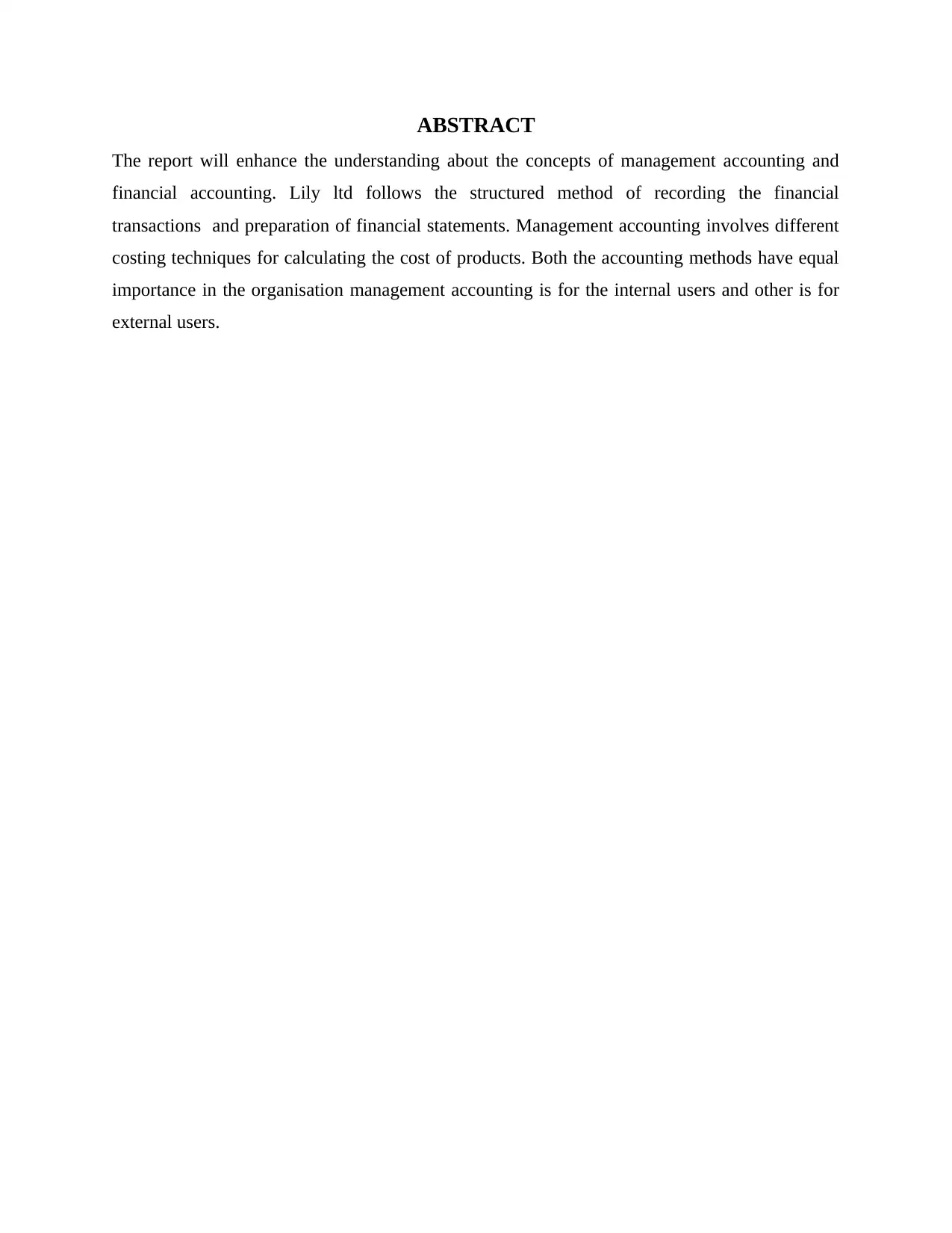
ABSTRACT
The report will enhance the understanding about the concepts of management accounting and
financial accounting. Lily ltd follows the structured method of recording the financial
transactions and preparation of financial statements. Management accounting involves different
costing techniques for calculating the cost of products. Both the accounting methods have equal
importance in the organisation management accounting is for the internal users and other is for
external users.
The report will enhance the understanding about the concepts of management accounting and
financial accounting. Lily ltd follows the structured method of recording the financial
transactions and preparation of financial statements. Management accounting involves different
costing techniques for calculating the cost of products. Both the accounting methods have equal
importance in the organisation management accounting is for the internal users and other is for
external users.
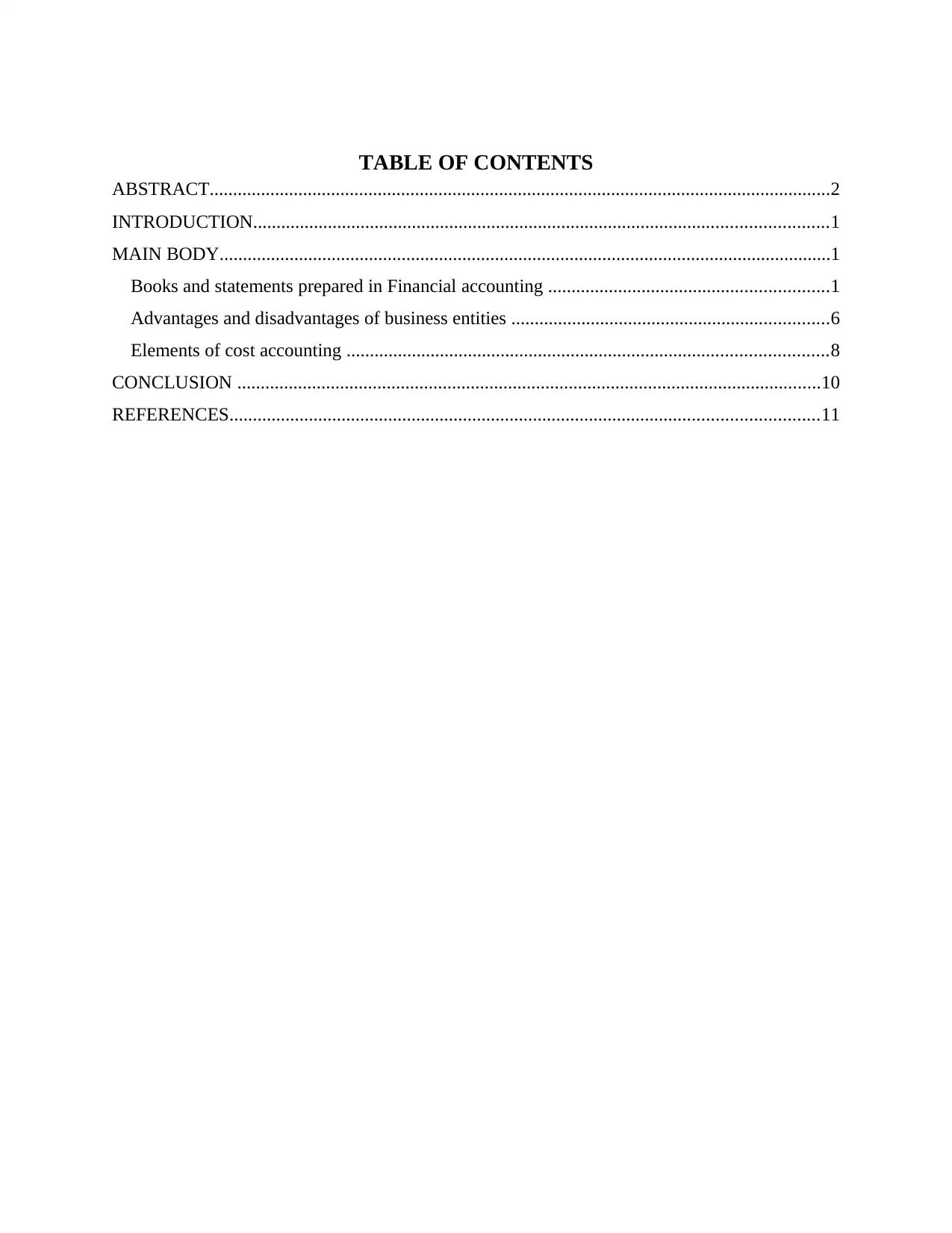
TABLE OF CONTENTS
ABSTRACT.....................................................................................................................................2
INTRODUCTION...........................................................................................................................1
MAIN BODY...................................................................................................................................1
Books and statements prepared in Financial accounting ............................................................1
Advantages and disadvantages of business entities ....................................................................6
Elements of cost accounting .......................................................................................................8
CONCLUSION .............................................................................................................................10
REFERENCES..............................................................................................................................11
ABSTRACT.....................................................................................................................................2
INTRODUCTION...........................................................................................................................1
MAIN BODY...................................................................................................................................1
Books and statements prepared in Financial accounting ............................................................1
Advantages and disadvantages of business entities ....................................................................6
Elements of cost accounting .......................................................................................................8
CONCLUSION .............................................................................................................................10
REFERENCES..............................................................................................................................11
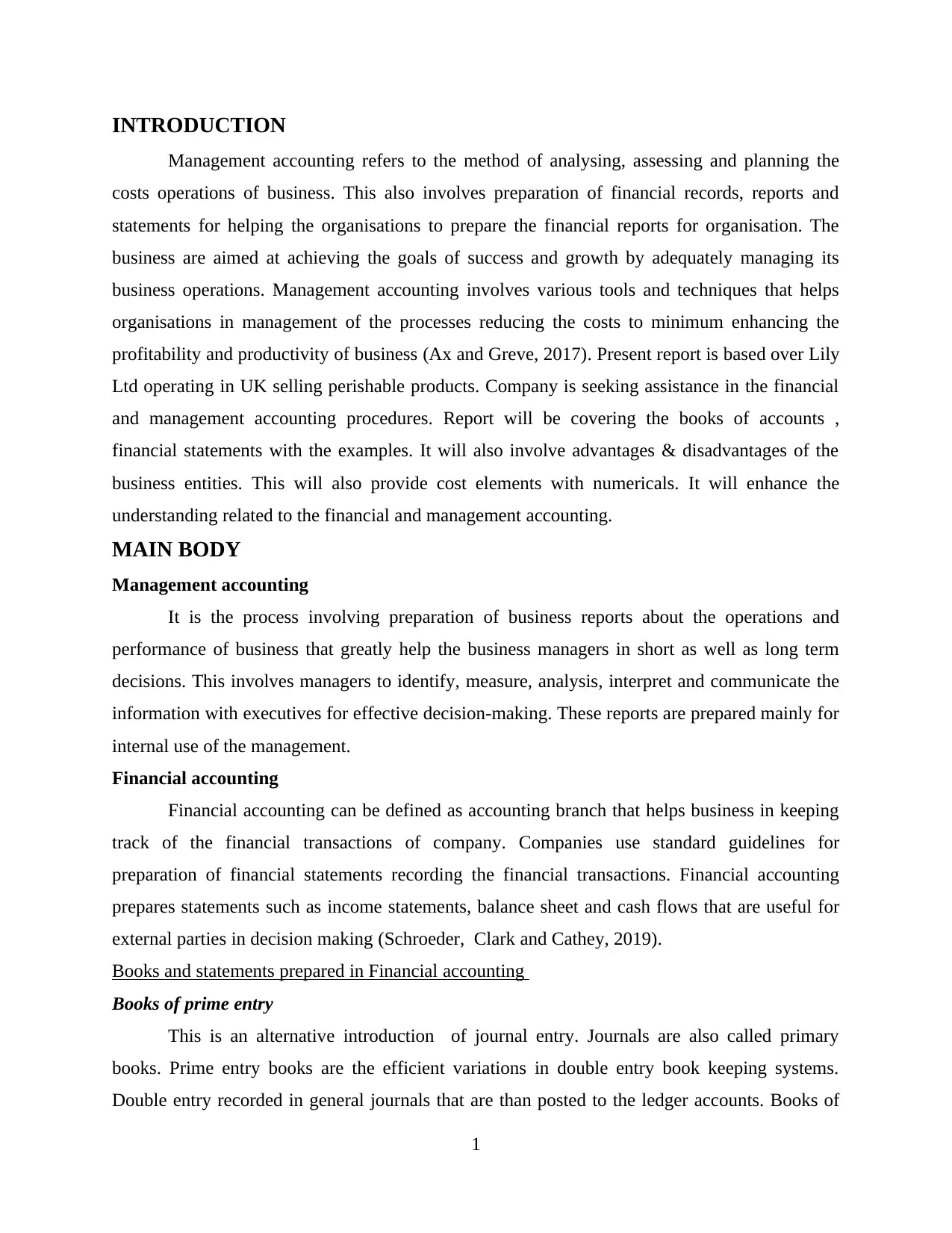
INTRODUCTION
Management accounting refers to the method of analysing, assessing and planning the
costs operations of business. This also involves preparation of financial records, reports and
statements for helping the organisations to prepare the financial reports for organisation. The
business are aimed at achieving the goals of success and growth by adequately managing its
business operations. Management accounting involves various tools and techniques that helps
organisations in management of the processes reducing the costs to minimum enhancing the
profitability and productivity of business (Ax and Greve, 2017). Present report is based over Lily
Ltd operating in UK selling perishable products. Company is seeking assistance in the financial
and management accounting procedures. Report will be covering the books of accounts ,
financial statements with the examples. It will also involve advantages & disadvantages of the
business entities. This will also provide cost elements with numericals. It will enhance the
understanding related to the financial and management accounting.
MAIN BODY
Management accounting
It is the process involving preparation of business reports about the operations and
performance of business that greatly help the business managers in short as well as long term
decisions. This involves managers to identify, measure, analysis, interpret and communicate the
information with executives for effective decision-making. These reports are prepared mainly for
internal use of the management.
Financial accounting
Financial accounting can be defined as accounting branch that helps business in keeping
track of the financial transactions of company. Companies use standard guidelines for
preparation of financial statements recording the financial transactions. Financial accounting
prepares statements such as income statements, balance sheet and cash flows that are useful for
external parties in decision making (Schroeder, Clark and Cathey, 2019).
Books and statements prepared in Financial accounting
Books of prime entry
This is an alternative introduction of journal entry. Journals are also called primary
books. Prime entry books are the efficient variations in double entry book keeping systems.
Double entry recorded in general journals that are than posted to the ledger accounts. Books of
1
Management accounting refers to the method of analysing, assessing and planning the
costs operations of business. This also involves preparation of financial records, reports and
statements for helping the organisations to prepare the financial reports for organisation. The
business are aimed at achieving the goals of success and growth by adequately managing its
business operations. Management accounting involves various tools and techniques that helps
organisations in management of the processes reducing the costs to minimum enhancing the
profitability and productivity of business (Ax and Greve, 2017). Present report is based over Lily
Ltd operating in UK selling perishable products. Company is seeking assistance in the financial
and management accounting procedures. Report will be covering the books of accounts ,
financial statements with the examples. It will also involve advantages & disadvantages of the
business entities. This will also provide cost elements with numericals. It will enhance the
understanding related to the financial and management accounting.
MAIN BODY
Management accounting
It is the process involving preparation of business reports about the operations and
performance of business that greatly help the business managers in short as well as long term
decisions. This involves managers to identify, measure, analysis, interpret and communicate the
information with executives for effective decision-making. These reports are prepared mainly for
internal use of the management.
Financial accounting
Financial accounting can be defined as accounting branch that helps business in keeping
track of the financial transactions of company. Companies use standard guidelines for
preparation of financial statements recording the financial transactions. Financial accounting
prepares statements such as income statements, balance sheet and cash flows that are useful for
external parties in decision making (Schroeder, Clark and Cathey, 2019).
Books and statements prepared in Financial accounting
Books of prime entry
This is an alternative introduction of journal entry. Journals are also called primary
books. Prime entry books are the efficient variations in double entry book keeping systems.
Double entry recorded in general journals that are than posted to the ledger accounts. Books of
1
Secure Best Marks with AI Grader
Need help grading? Try our AI Grader for instant feedback on your assignments.
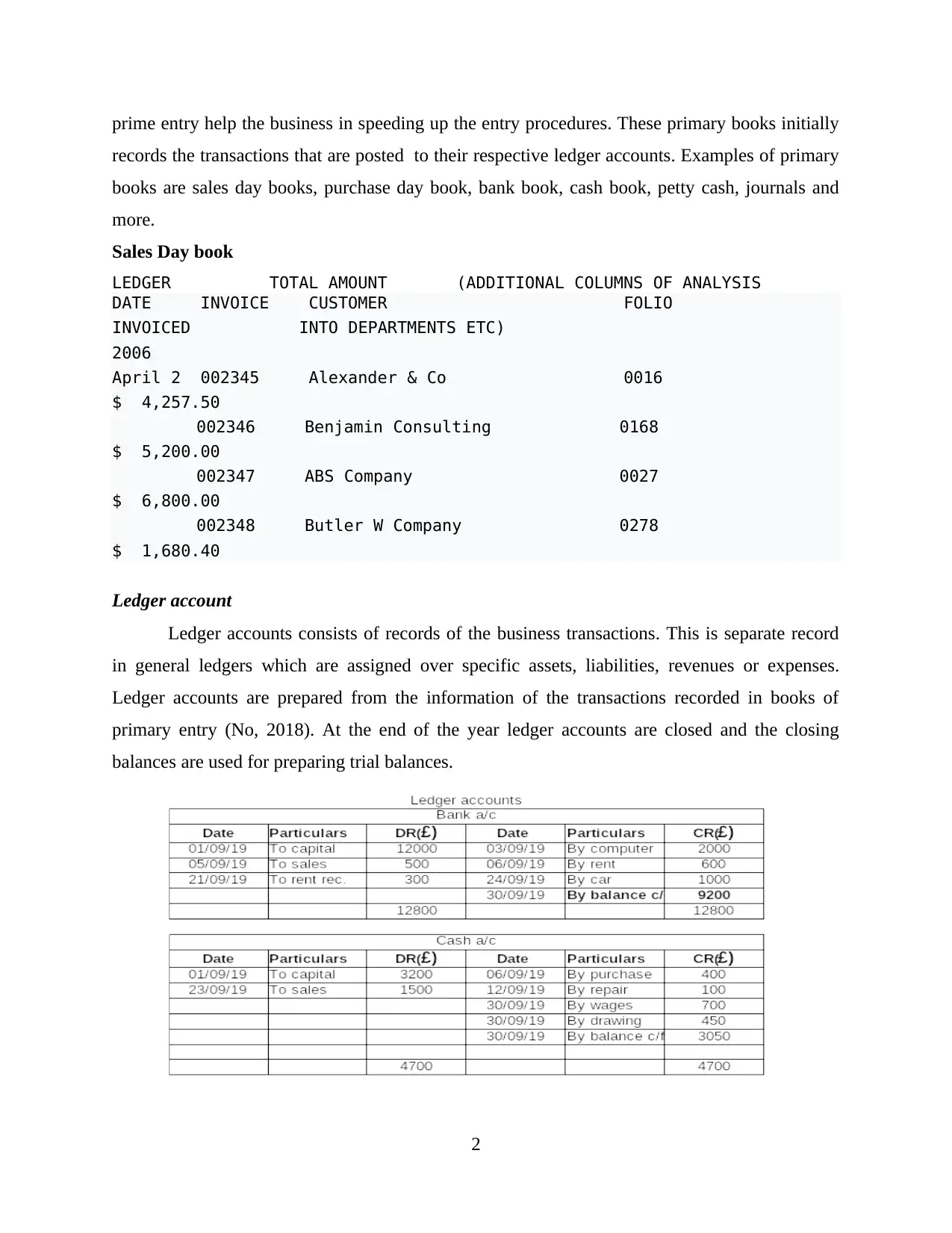
prime entry help the business in speeding up the entry procedures. These primary books initially
records the transactions that are posted to their respective ledger accounts. Examples of primary
books are sales day books, purchase day book, bank book, cash book, petty cash, journals and
more.
Sales Day book
LEDGER TOTAL AMOUNT (ADDITIONAL COLUMNS OF ANALYSIS
DATE INVOICE CUSTOMER FOLIO
INVOICED INTO DEPARTMENTS ETC)
2006
April 2 002345 Alexander & Co 0016
$ 4,257.50
002346 Benjamin Consulting 0168
$ 5,200.00
002347 ABS Company 0027
$ 6,800.00
002348 Butler W Company 0278
$ 1,680.40
Ledger account
Ledger accounts consists of records of the business transactions. This is separate record
in general ledgers which are assigned over specific assets, liabilities, revenues or expenses.
Ledger accounts are prepared from the information of the transactions recorded in books of
primary entry (No, 2018). At the end of the year ledger accounts are closed and the closing
balances are used for preparing trial balances.
2
records the transactions that are posted to their respective ledger accounts. Examples of primary
books are sales day books, purchase day book, bank book, cash book, petty cash, journals and
more.
Sales Day book
LEDGER TOTAL AMOUNT (ADDITIONAL COLUMNS OF ANALYSIS
DATE INVOICE CUSTOMER FOLIO
INVOICED INTO DEPARTMENTS ETC)
2006
April 2 002345 Alexander & Co 0016
$ 4,257.50
002346 Benjamin Consulting 0168
$ 5,200.00
002347 ABS Company 0027
$ 6,800.00
002348 Butler W Company 0278
$ 1,680.40
Ledger account
Ledger accounts consists of records of the business transactions. This is separate record
in general ledgers which are assigned over specific assets, liabilities, revenues or expenses.
Ledger accounts are prepared from the information of the transactions recorded in books of
primary entry (No, 2018). At the end of the year ledger accounts are closed and the closing
balances are used for preparing trial balances.
2
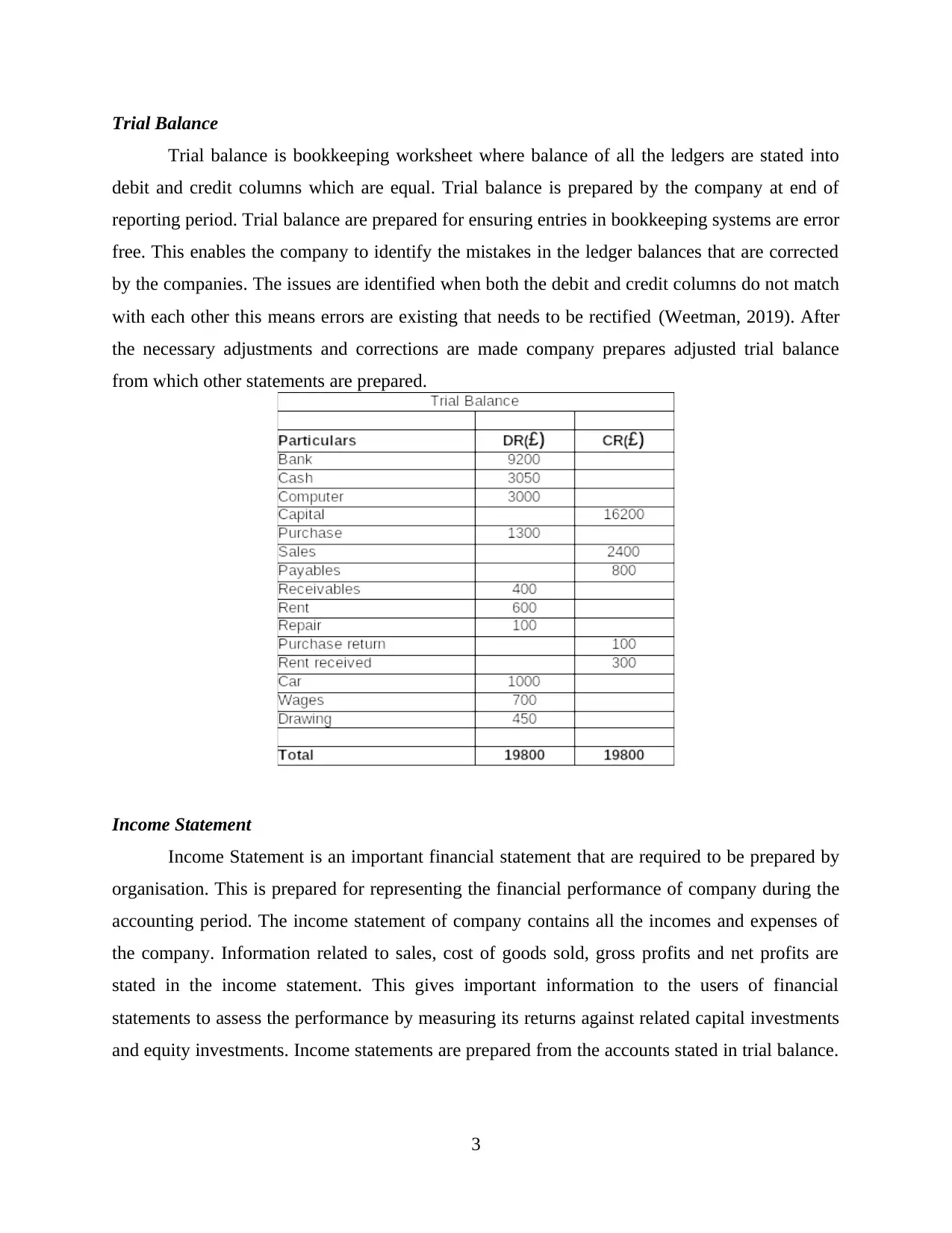
Trial Balance
Trial balance is bookkeeping worksheet where balance of all the ledgers are stated into
debit and credit columns which are equal. Trial balance is prepared by the company at end of
reporting period. Trial balance are prepared for ensuring entries in bookkeeping systems are error
free. This enables the company to identify the mistakes in the ledger balances that are corrected
by the companies. The issues are identified when both the debit and credit columns do not match
with each other this means errors are existing that needs to be rectified (Weetman, 2019). After
the necessary adjustments and corrections are made company prepares adjusted trial balance
from which other statements are prepared.
Income Statement
Income Statement is an important financial statement that are required to be prepared by
organisation. This is prepared for representing the financial performance of company during the
accounting period. The income statement of company contains all the incomes and expenses of
the company. Information related to sales, cost of goods sold, gross profits and net profits are
stated in the income statement. This gives important information to the users of financial
statements to assess the performance by measuring its returns against related capital investments
and equity investments. Income statements are prepared from the accounts stated in trial balance.
3
Trial balance is bookkeeping worksheet where balance of all the ledgers are stated into
debit and credit columns which are equal. Trial balance is prepared by the company at end of
reporting period. Trial balance are prepared for ensuring entries in bookkeeping systems are error
free. This enables the company to identify the mistakes in the ledger balances that are corrected
by the companies. The issues are identified when both the debit and credit columns do not match
with each other this means errors are existing that needs to be rectified (Weetman, 2019). After
the necessary adjustments and corrections are made company prepares adjusted trial balance
from which other statements are prepared.
Income Statement
Income Statement is an important financial statement that are required to be prepared by
organisation. This is prepared for representing the financial performance of company during the
accounting period. The income statement of company contains all the incomes and expenses of
the company. Information related to sales, cost of goods sold, gross profits and net profits are
stated in the income statement. This gives important information to the users of financial
statements to assess the performance by measuring its returns against related capital investments
and equity investments. Income statements are prepared from the accounts stated in trial balance.
3
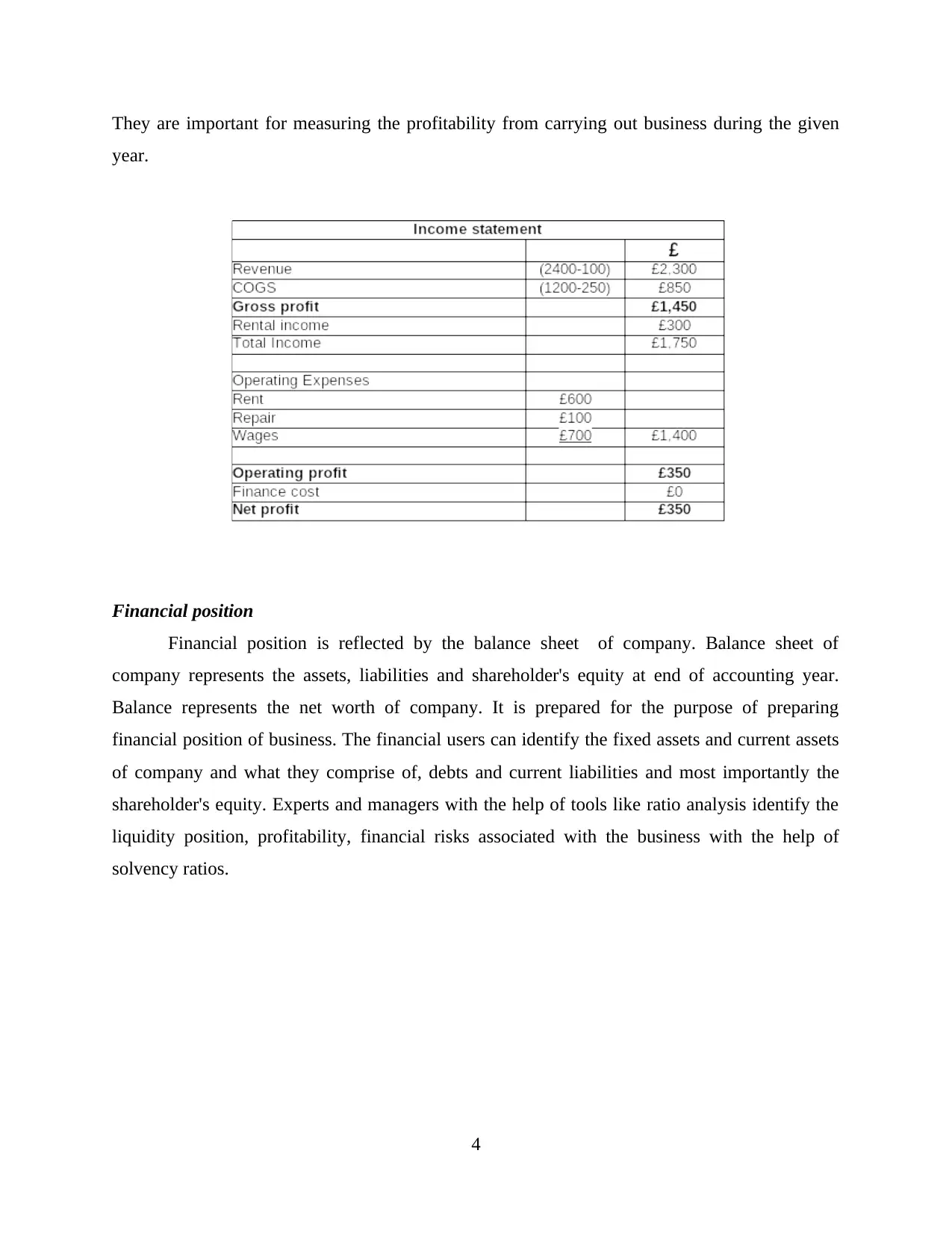
They are important for measuring the profitability from carrying out business during the given
year.
Financial position
Financial position is reflected by the balance sheet of company. Balance sheet of
company represents the assets, liabilities and shareholder's equity at end of accounting year.
Balance represents the net worth of company. It is prepared for the purpose of preparing
financial position of business. The financial users can identify the fixed assets and current assets
of company and what they comprise of, debts and current liabilities and most importantly the
shareholder's equity. Experts and managers with the help of tools like ratio analysis identify the
liquidity position, profitability, financial risks associated with the business with the help of
solvency ratios.
4
year.
Financial position
Financial position is reflected by the balance sheet of company. Balance sheet of
company represents the assets, liabilities and shareholder's equity at end of accounting year.
Balance represents the net worth of company. It is prepared for the purpose of preparing
financial position of business. The financial users can identify the fixed assets and current assets
of company and what they comprise of, debts and current liabilities and most importantly the
shareholder's equity. Experts and managers with the help of tools like ratio analysis identify the
liquidity position, profitability, financial risks associated with the business with the help of
solvency ratios.
4
Paraphrase This Document
Need a fresh take? Get an instant paraphrase of this document with our AI Paraphraser
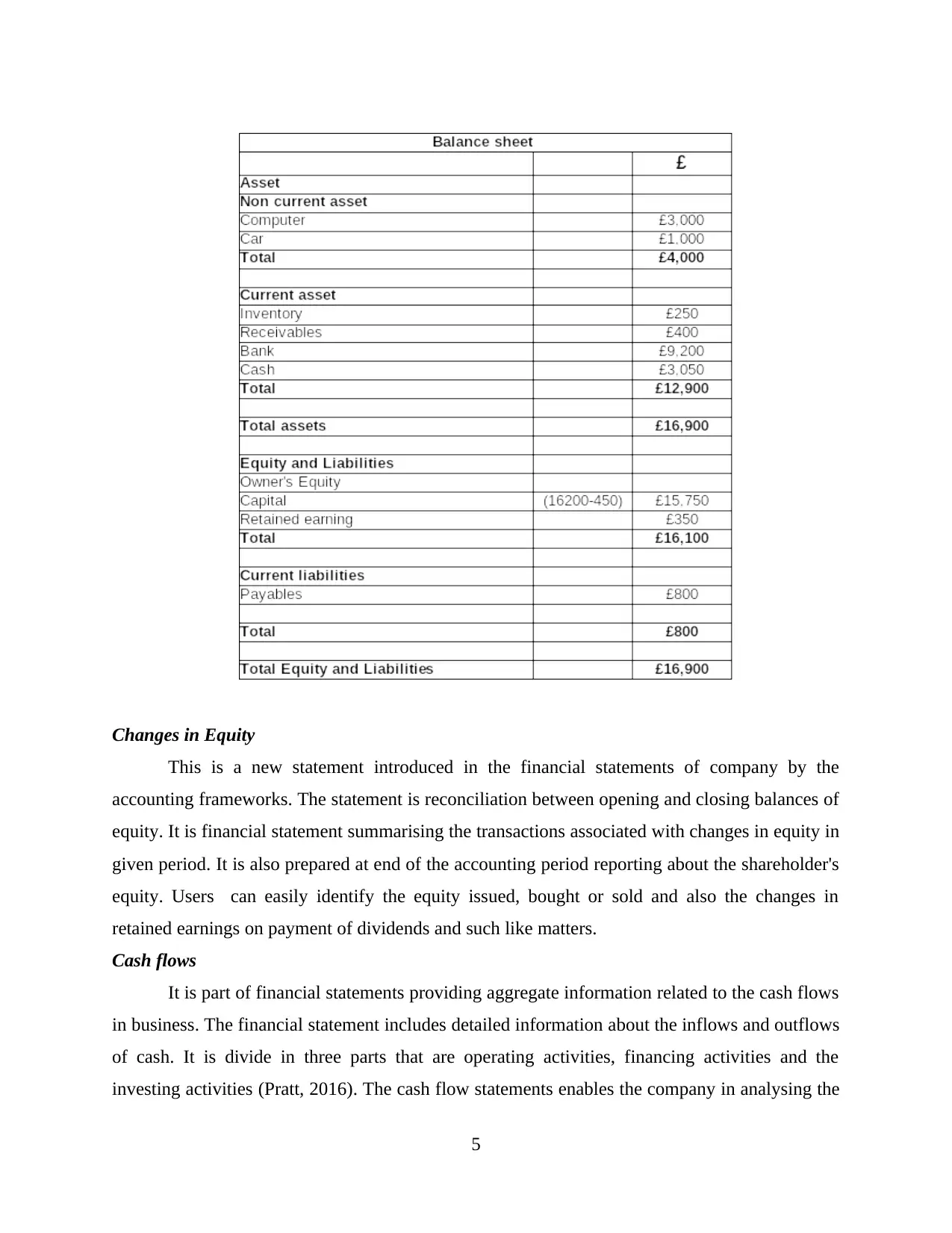
Changes in Equity
This is a new statement introduced in the financial statements of company by the
accounting frameworks. The statement is reconciliation between opening and closing balances of
equity. It is financial statement summarising the transactions associated with changes in equity in
given period. It is also prepared at end of the accounting period reporting about the shareholder's
equity. Users can easily identify the equity issued, bought or sold and also the changes in
retained earnings on payment of dividends and such like matters.
Cash flows
It is part of financial statements providing aggregate information related to the cash flows
in business. The financial statement includes detailed information about the inflows and outflows
of cash. It is divide in three parts that are operating activities, financing activities and the
investing activities (Pratt, 2016). The cash flow statements enables the company in analysing the
5
This is a new statement introduced in the financial statements of company by the
accounting frameworks. The statement is reconciliation between opening and closing balances of
equity. It is financial statement summarising the transactions associated with changes in equity in
given period. It is also prepared at end of the accounting period reporting about the shareholder's
equity. Users can easily identify the equity issued, bought or sold and also the changes in
retained earnings on payment of dividends and such like matters.
Cash flows
It is part of financial statements providing aggregate information related to the cash flows
in business. The financial statement includes detailed information about the inflows and outflows
of cash. It is divide in three parts that are operating activities, financing activities and the
investing activities (Pratt, 2016). The cash flow statements enables the company in analysing the
5
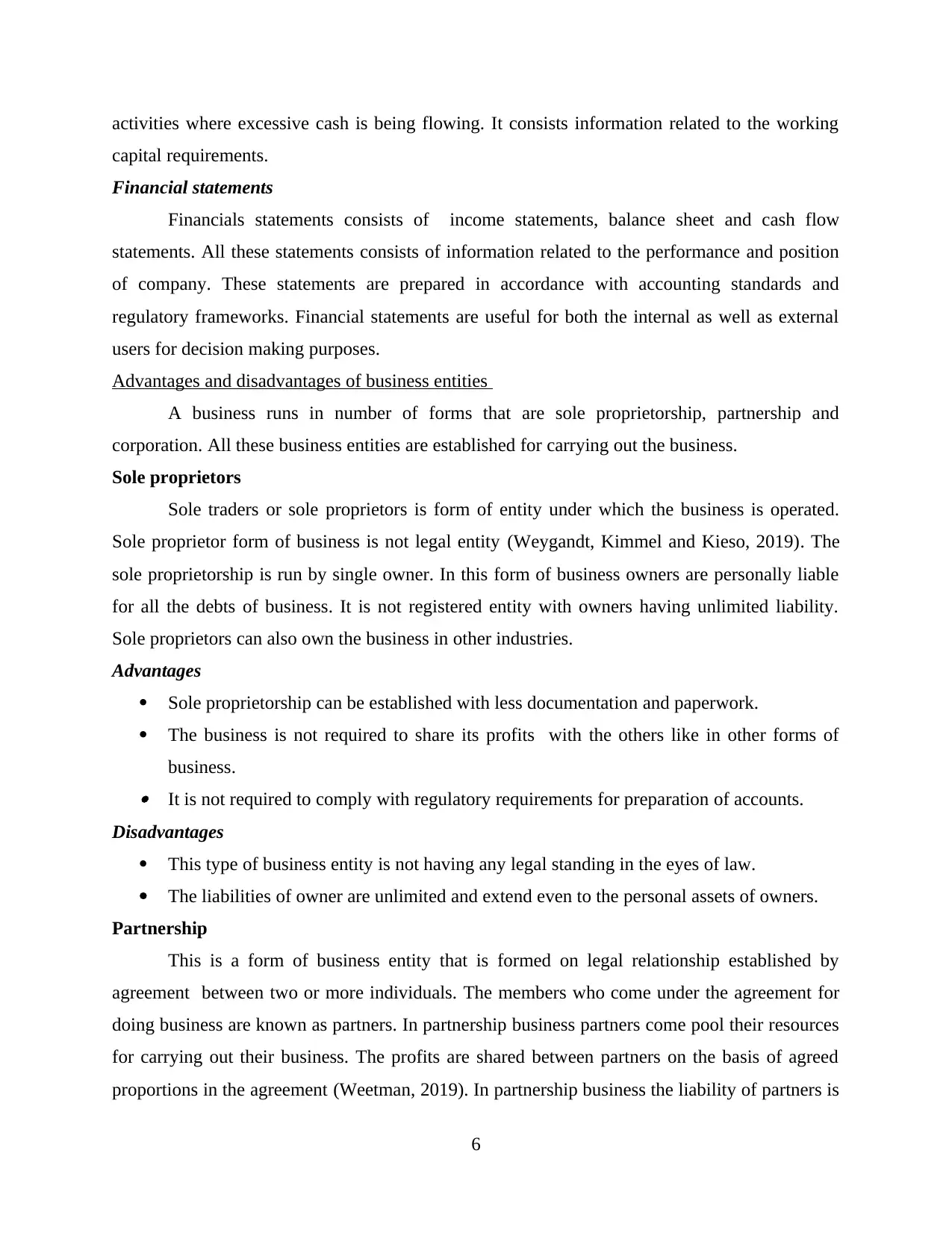
activities where excessive cash is being flowing. It consists information related to the working
capital requirements.
Financial statements
Financials statements consists of income statements, balance sheet and cash flow
statements. All these statements consists of information related to the performance and position
of company. These statements are prepared in accordance with accounting standards and
regulatory frameworks. Financial statements are useful for both the internal as well as external
users for decision making purposes.
Advantages and disadvantages of business entities
A business runs in number of forms that are sole proprietorship, partnership and
corporation. All these business entities are established for carrying out the business.
Sole proprietors
Sole traders or sole proprietors is form of entity under which the business is operated.
Sole proprietor form of business is not legal entity (Weygandt, Kimmel and Kieso, 2019). The
sole proprietorship is run by single owner. In this form of business owners are personally liable
for all the debts of business. It is not registered entity with owners having unlimited liability.
Sole proprietors can also own the business in other industries.
Advantages
Sole proprietorship can be established with less documentation and paperwork.
The business is not required to share its profits with the others like in other forms of
business. It is not required to comply with regulatory requirements for preparation of accounts.
Disadvantages
This type of business entity is not having any legal standing in the eyes of law.
The liabilities of owner are unlimited and extend even to the personal assets of owners.
Partnership
This is a form of business entity that is formed on legal relationship established by
agreement between two or more individuals. The members who come under the agreement for
doing business are known as partners. In partnership business partners come pool their resources
for carrying out their business. The profits are shared between partners on the basis of agreed
proportions in the agreement (Weetman, 2019). In partnership business the liability of partners is
6
capital requirements.
Financial statements
Financials statements consists of income statements, balance sheet and cash flow
statements. All these statements consists of information related to the performance and position
of company. These statements are prepared in accordance with accounting standards and
regulatory frameworks. Financial statements are useful for both the internal as well as external
users for decision making purposes.
Advantages and disadvantages of business entities
A business runs in number of forms that are sole proprietorship, partnership and
corporation. All these business entities are established for carrying out the business.
Sole proprietors
Sole traders or sole proprietors is form of entity under which the business is operated.
Sole proprietor form of business is not legal entity (Weygandt, Kimmel and Kieso, 2019). The
sole proprietorship is run by single owner. In this form of business owners are personally liable
for all the debts of business. It is not registered entity with owners having unlimited liability.
Sole proprietors can also own the business in other industries.
Advantages
Sole proprietorship can be established with less documentation and paperwork.
The business is not required to share its profits with the others like in other forms of
business. It is not required to comply with regulatory requirements for preparation of accounts.
Disadvantages
This type of business entity is not having any legal standing in the eyes of law.
The liabilities of owner are unlimited and extend even to the personal assets of owners.
Partnership
This is a form of business entity that is formed on legal relationship established by
agreement between two or more individuals. The members who come under the agreement for
doing business are known as partners. In partnership business partners come pool their resources
for carrying out their business. The profits are shared between partners on the basis of agreed
proportions in the agreement (Weetman, 2019). In partnership business the liability of partners is
6
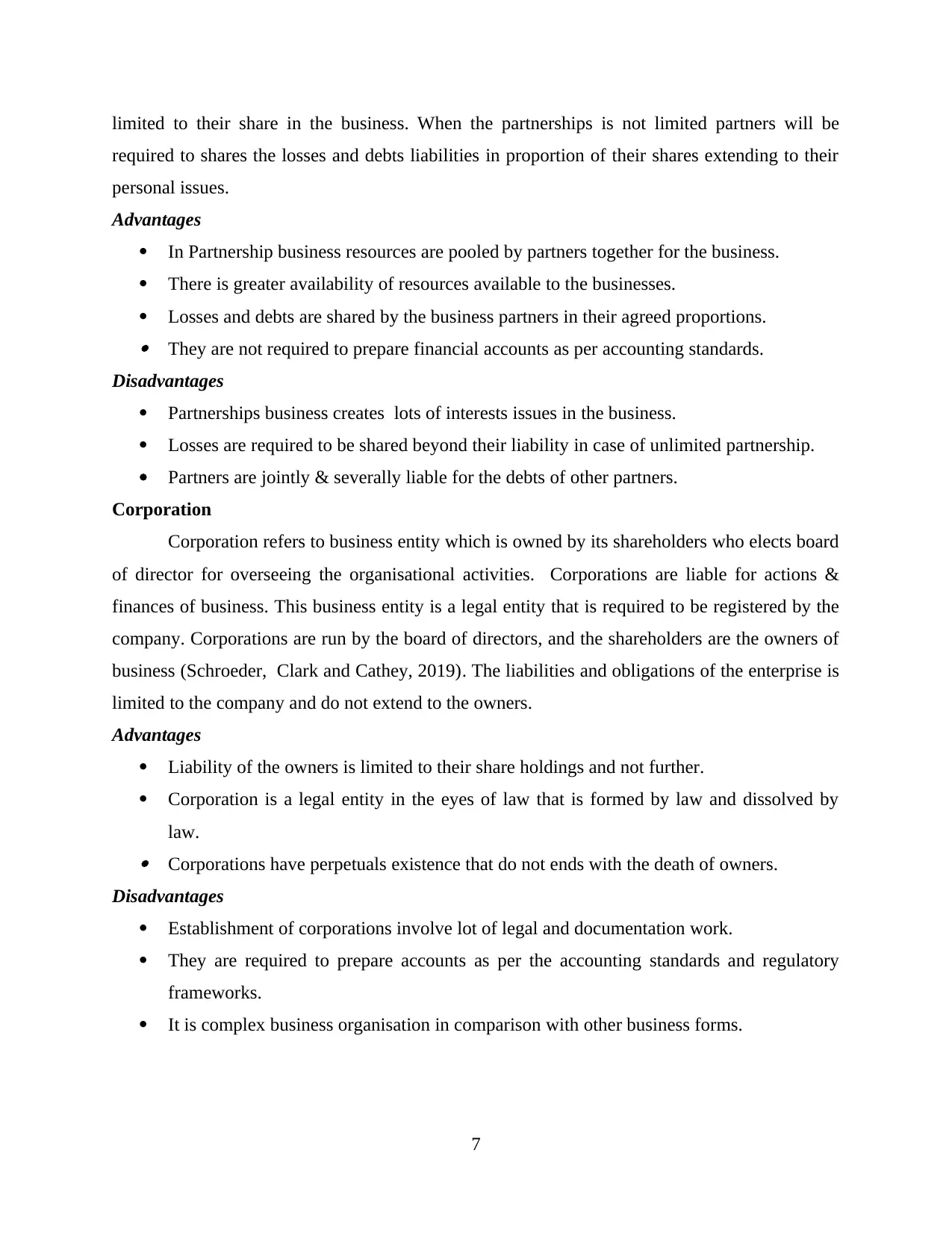
limited to their share in the business. When the partnerships is not limited partners will be
required to shares the losses and debts liabilities in proportion of their shares extending to their
personal issues.
Advantages
In Partnership business resources are pooled by partners together for the business.
There is greater availability of resources available to the businesses.
Losses and debts are shared by the business partners in their agreed proportions. They are not required to prepare financial accounts as per accounting standards.
Disadvantages
Partnerships business creates lots of interests issues in the business.
Losses are required to be shared beyond their liability in case of unlimited partnership.
Partners are jointly & severally liable for the debts of other partners.
Corporation
Corporation refers to business entity which is owned by its shareholders who elects board
of director for overseeing the organisational activities. Corporations are liable for actions &
finances of business. This business entity is a legal entity that is required to be registered by the
company. Corporations are run by the board of directors, and the shareholders are the owners of
business (Schroeder, Clark and Cathey, 2019). The liabilities and obligations of the enterprise is
limited to the company and do not extend to the owners.
Advantages
Liability of the owners is limited to their share holdings and not further.
Corporation is a legal entity in the eyes of law that is formed by law and dissolved by
law. Corporations have perpetuals existence that do not ends with the death of owners.
Disadvantages
Establishment of corporations involve lot of legal and documentation work.
They are required to prepare accounts as per the accounting standards and regulatory
frameworks.
It is complex business organisation in comparison with other business forms.
7
required to shares the losses and debts liabilities in proportion of their shares extending to their
personal issues.
Advantages
In Partnership business resources are pooled by partners together for the business.
There is greater availability of resources available to the businesses.
Losses and debts are shared by the business partners in their agreed proportions. They are not required to prepare financial accounts as per accounting standards.
Disadvantages
Partnerships business creates lots of interests issues in the business.
Losses are required to be shared beyond their liability in case of unlimited partnership.
Partners are jointly & severally liable for the debts of other partners.
Corporation
Corporation refers to business entity which is owned by its shareholders who elects board
of director for overseeing the organisational activities. Corporations are liable for actions &
finances of business. This business entity is a legal entity that is required to be registered by the
company. Corporations are run by the board of directors, and the shareholders are the owners of
business (Schroeder, Clark and Cathey, 2019). The liabilities and obligations of the enterprise is
limited to the company and do not extend to the owners.
Advantages
Liability of the owners is limited to their share holdings and not further.
Corporation is a legal entity in the eyes of law that is formed by law and dissolved by
law. Corporations have perpetuals existence that do not ends with the death of owners.
Disadvantages
Establishment of corporations involve lot of legal and documentation work.
They are required to prepare accounts as per the accounting standards and regulatory
frameworks.
It is complex business organisation in comparison with other business forms.
7
Secure Best Marks with AI Grader
Need help grading? Try our AI Grader for instant feedback on your assignments.
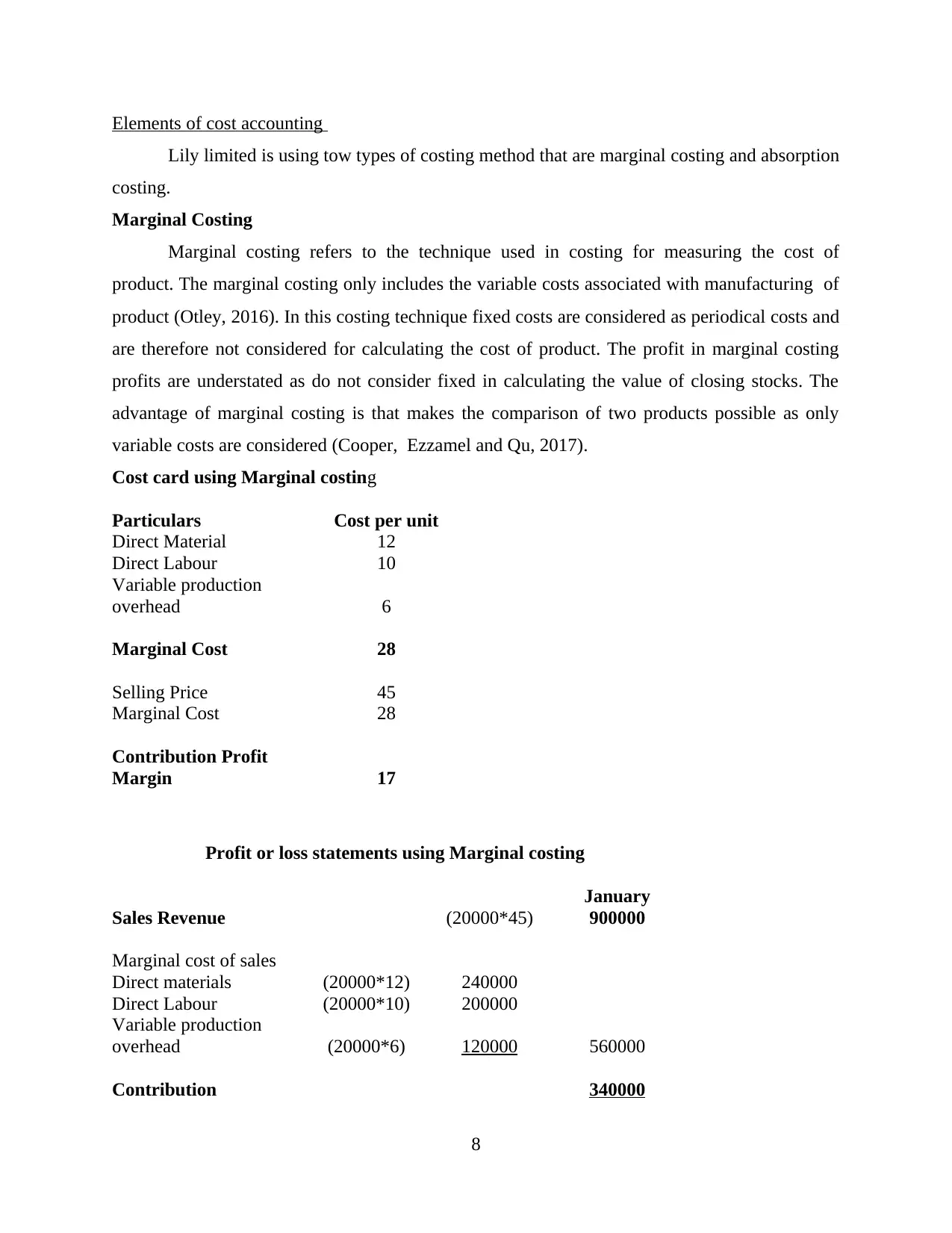
Elements of cost accounting
Lily limited is using tow types of costing method that are marginal costing and absorption
costing.
Marginal Costing
Marginal costing refers to the technique used in costing for measuring the cost of
product. The marginal costing only includes the variable costs associated with manufacturing of
product (Otley, 2016). In this costing technique fixed costs are considered as periodical costs and
are therefore not considered for calculating the cost of product. The profit in marginal costing
profits are understated as do not consider fixed in calculating the value of closing stocks. The
advantage of marginal costing is that makes the comparison of two products possible as only
variable costs are considered (Cooper, Ezzamel and Qu, 2017).
Cost card using Marginal costing
Particulars Cost per unit
Direct Material 12
Direct Labour 10
Variable production
overhead 6
Marginal Cost 28
Selling Price 45
Marginal Cost 28
Contribution Profit
Margin 17
Profit or loss statements using Marginal costing
January
Sales Revenue (20000*45) 900000
Marginal cost of sales
Direct materials (20000*12) 240000
Direct Labour (20000*10) 200000
Variable production
overhead (20000*6) 120000 560000
Contribution 340000
8
Lily limited is using tow types of costing method that are marginal costing and absorption
costing.
Marginal Costing
Marginal costing refers to the technique used in costing for measuring the cost of
product. The marginal costing only includes the variable costs associated with manufacturing of
product (Otley, 2016). In this costing technique fixed costs are considered as periodical costs and
are therefore not considered for calculating the cost of product. The profit in marginal costing
profits are understated as do not consider fixed in calculating the value of closing stocks. The
advantage of marginal costing is that makes the comparison of two products possible as only
variable costs are considered (Cooper, Ezzamel and Qu, 2017).
Cost card using Marginal costing
Particulars Cost per unit
Direct Material 12
Direct Labour 10
Variable production
overhead 6
Marginal Cost 28
Selling Price 45
Marginal Cost 28
Contribution Profit
Margin 17
Profit or loss statements using Marginal costing
January
Sales Revenue (20000*45) 900000
Marginal cost of sales
Direct materials (20000*12) 240000
Direct Labour (20000*10) 200000
Variable production
overhead (20000*6) 120000 560000
Contribution 340000
8
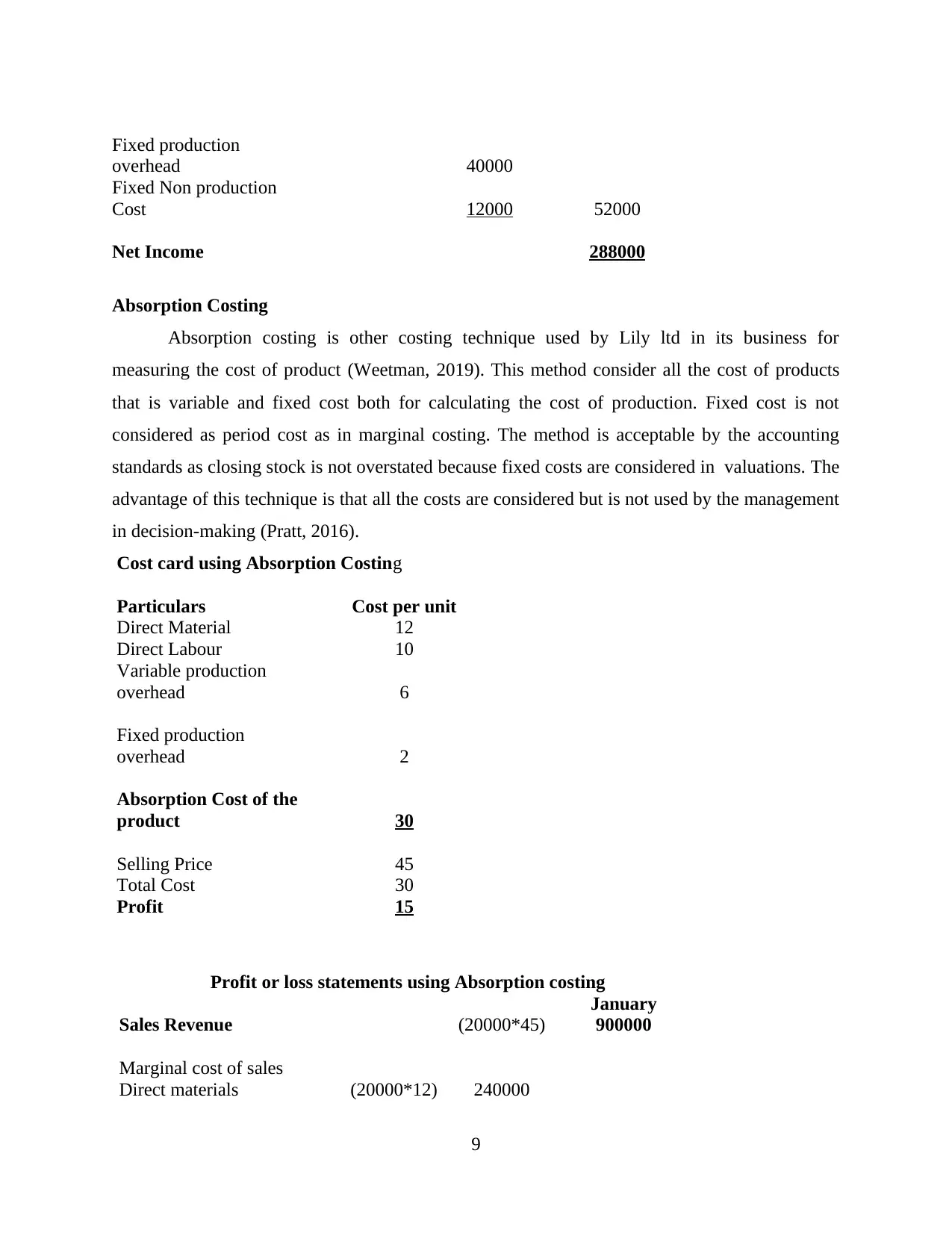
Fixed production
overhead 40000
Fixed Non production
Cost 12000 52000
Net Income 288000
Absorption Costing
Absorption costing is other costing technique used by Lily ltd in its business for
measuring the cost of product (Weetman, 2019). This method consider all the cost of products
that is variable and fixed cost both for calculating the cost of production. Fixed cost is not
considered as period cost as in marginal costing. The method is acceptable by the accounting
standards as closing stock is not overstated because fixed costs are considered in valuations. The
advantage of this technique is that all the costs are considered but is not used by the management
in decision-making (Pratt, 2016).
Cost card using Absorption Costing
Particulars Cost per unit
Direct Material 12
Direct Labour 10
Variable production
overhead 6
Fixed production
overhead 2
Absorption Cost of the
product 30
Selling Price 45
Total Cost 30
Profit 15
Profit or loss statements using Absorption costing
January
Sales Revenue (20000*45) 900000
Marginal cost of sales
Direct materials (20000*12) 240000
9
overhead 40000
Fixed Non production
Cost 12000 52000
Net Income 288000
Absorption Costing
Absorption costing is other costing technique used by Lily ltd in its business for
measuring the cost of product (Weetman, 2019). This method consider all the cost of products
that is variable and fixed cost both for calculating the cost of production. Fixed cost is not
considered as period cost as in marginal costing. The method is acceptable by the accounting
standards as closing stock is not overstated because fixed costs are considered in valuations. The
advantage of this technique is that all the costs are considered but is not used by the management
in decision-making (Pratt, 2016).
Cost card using Absorption Costing
Particulars Cost per unit
Direct Material 12
Direct Labour 10
Variable production
overhead 6
Fixed production
overhead 2
Absorption Cost of the
product 30
Selling Price 45
Total Cost 30
Profit 15
Profit or loss statements using Absorption costing
January
Sales Revenue (20000*45) 900000
Marginal cost of sales
Direct materials (20000*12) 240000
9
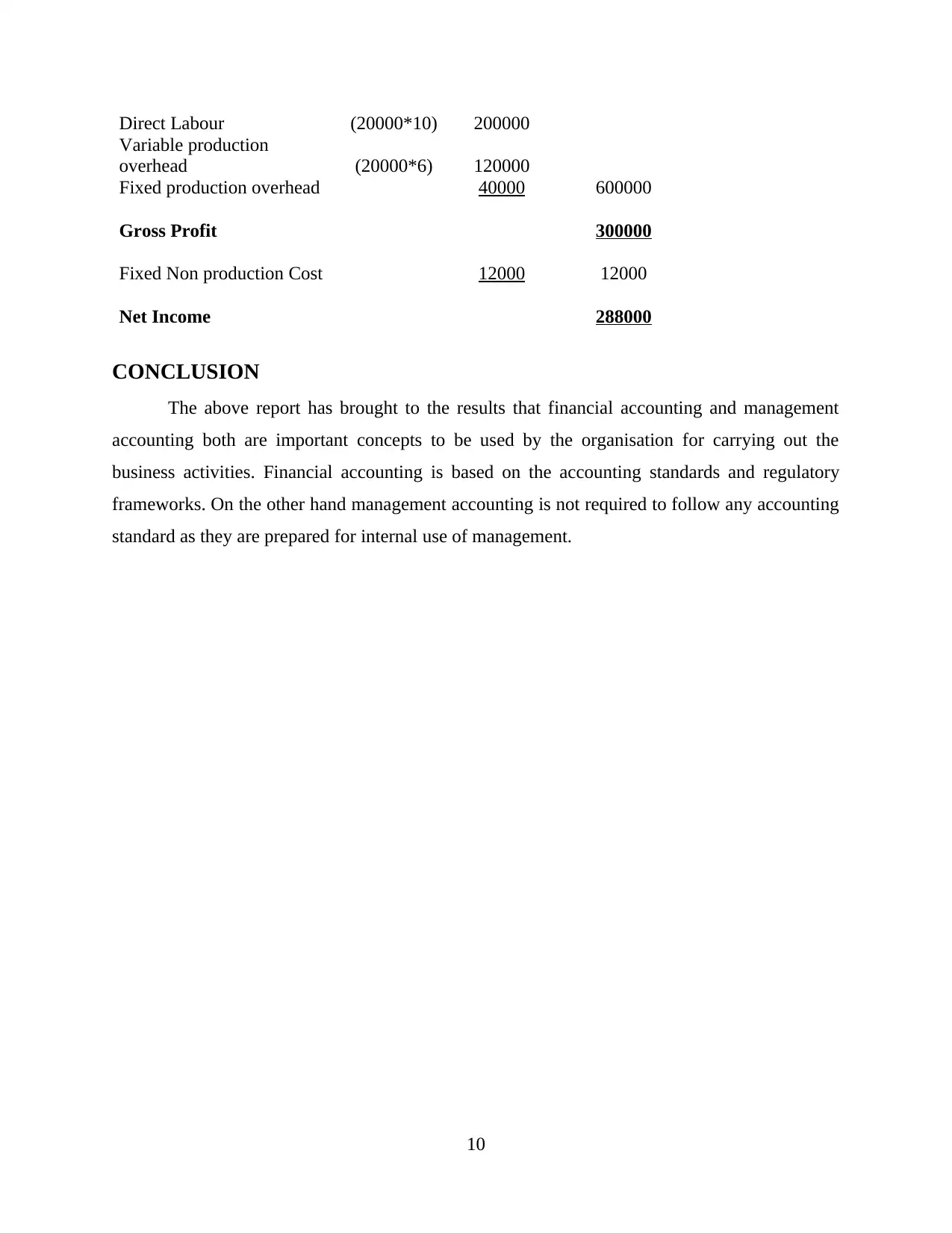
Direct Labour (20000*10) 200000
Variable production
overhead (20000*6) 120000
Fixed production overhead 40000 600000
Gross Profit 300000
Fixed Non production Cost 12000 12000
Net Income 288000
CONCLUSION
The above report has brought to the results that financial accounting and management
accounting both are important concepts to be used by the organisation for carrying out the
business activities. Financial accounting is based on the accounting standards and regulatory
frameworks. On the other hand management accounting is not required to follow any accounting
standard as they are prepared for internal use of management.
10
Variable production
overhead (20000*6) 120000
Fixed production overhead 40000 600000
Gross Profit 300000
Fixed Non production Cost 12000 12000
Net Income 288000
CONCLUSION
The above report has brought to the results that financial accounting and management
accounting both are important concepts to be used by the organisation for carrying out the
business activities. Financial accounting is based on the accounting standards and regulatory
frameworks. On the other hand management accounting is not required to follow any accounting
standard as they are prepared for internal use of management.
10
Paraphrase This Document
Need a fresh take? Get an instant paraphrase of this document with our AI Paraphraser
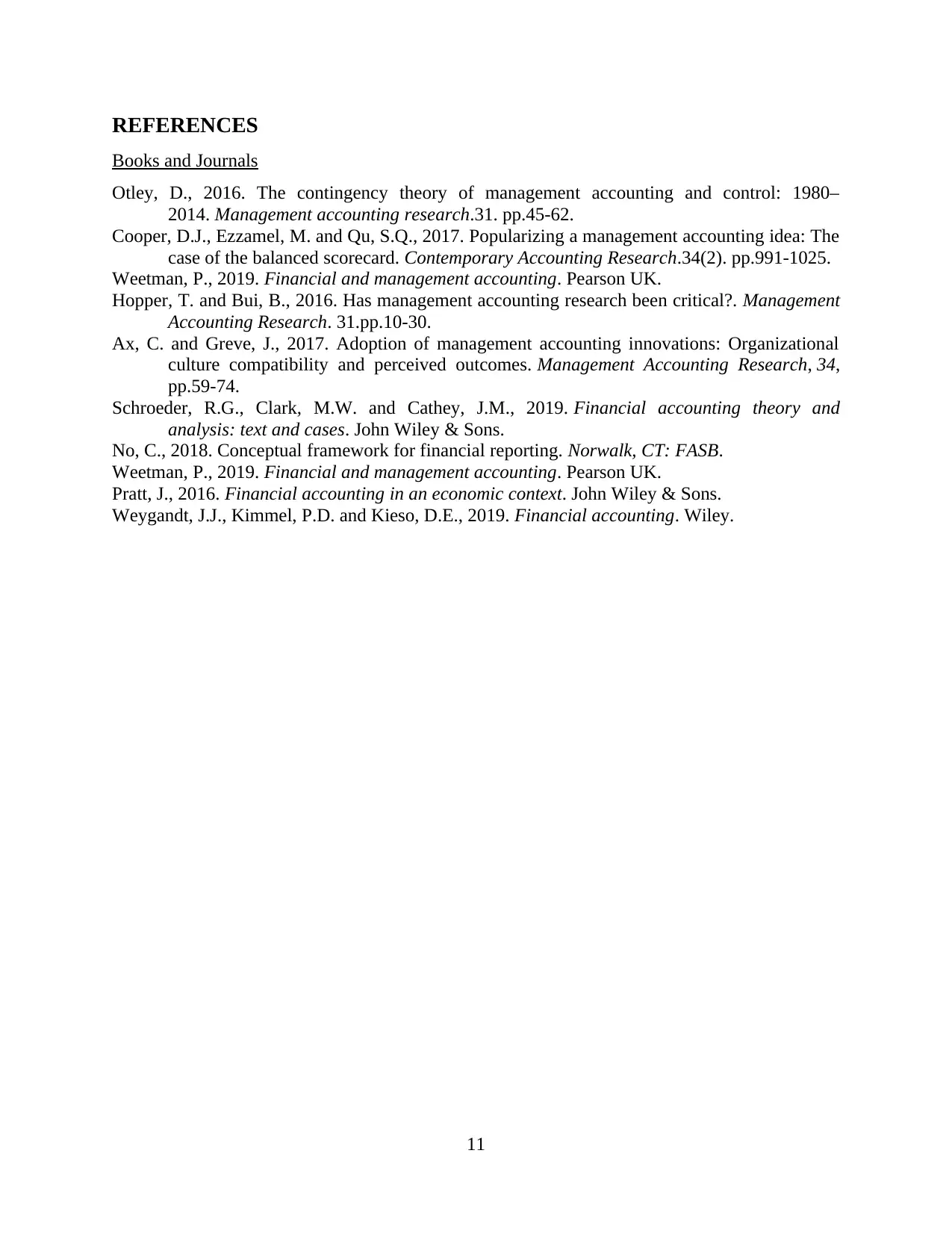
REFERENCES
Books and Journals
Otley, D., 2016. The contingency theory of management accounting and control: 1980–
2014. Management accounting research.31. pp.45-62.
Cooper, D.J., Ezzamel, M. and Qu, S.Q., 2017. Popularizing a management accounting idea: The
case of the balanced scorecard. Contemporary Accounting Research.34(2). pp.991-1025.
Weetman, P., 2019. Financial and management accounting. Pearson UK.
Hopper, T. and Bui, B., 2016. Has management accounting research been critical?. Management
Accounting Research. 31.pp.10-30.
Ax, C. and Greve, J., 2017. Adoption of management accounting innovations: Organizational
culture compatibility and perceived outcomes. Management Accounting Research, 34,
pp.59-74.
Schroeder, R.G., Clark, M.W. and Cathey, J.M., 2019. Financial accounting theory and
analysis: text and cases. John Wiley & Sons.
No, C., 2018. Conceptual framework for financial reporting. Norwalk, CT: FASB.
Weetman, P., 2019. Financial and management accounting. Pearson UK.
Pratt, J., 2016. Financial accounting in an economic context. John Wiley & Sons.
Weygandt, J.J., Kimmel, P.D. and Kieso, D.E., 2019. Financial accounting. Wiley.
11
Books and Journals
Otley, D., 2016. The contingency theory of management accounting and control: 1980–
2014. Management accounting research.31. pp.45-62.
Cooper, D.J., Ezzamel, M. and Qu, S.Q., 2017. Popularizing a management accounting idea: The
case of the balanced scorecard. Contemporary Accounting Research.34(2). pp.991-1025.
Weetman, P., 2019. Financial and management accounting. Pearson UK.
Hopper, T. and Bui, B., 2016. Has management accounting research been critical?. Management
Accounting Research. 31.pp.10-30.
Ax, C. and Greve, J., 2017. Adoption of management accounting innovations: Organizational
culture compatibility and perceived outcomes. Management Accounting Research, 34,
pp.59-74.
Schroeder, R.G., Clark, M.W. and Cathey, J.M., 2019. Financial accounting theory and
analysis: text and cases. John Wiley & Sons.
No, C., 2018. Conceptual framework for financial reporting. Norwalk, CT: FASB.
Weetman, P., 2019. Financial and management accounting. Pearson UK.
Pratt, J., 2016. Financial accounting in an economic context. John Wiley & Sons.
Weygandt, J.J., Kimmel, P.D. and Kieso, D.E., 2019. Financial accounting. Wiley.
11
1 out of 14
Related Documents
Your All-in-One AI-Powered Toolkit for Academic Success.
+13062052269
info@desklib.com
Available 24*7 on WhatsApp / Email
![[object Object]](/_next/static/media/star-bottom.7253800d.svg)
Unlock your academic potential
© 2024 | Zucol Services PVT LTD | All rights reserved.





